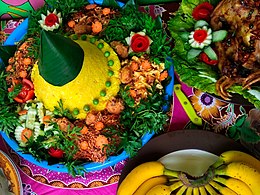
 |
| This article is part of the series on |
| Indonesian cuisine Masakan Indonesia |
|---|
|
|
Indonesian street food is a collection of ready-to-eat meals, snacks, fruits and drinks sold by hawkers or vendors at warung food stalls or food carts. Street food in Indonesia is a diverse mix of local Indonesian, Chinese, and Dutch influences.[1] Indonesian street food is usually cheap, offers a great variety of food of different tastes, and can be found at every corner of the city.[2]
Most Indonesian street food is affordable, with prices usually less than 1 US dollar (around 15,000.00 rupiah). However, there are also some street foods that are priced more than 20,000 rupiah (1.30 US dollar). Indonesian street food is often colloquially called as kaki lima (Indonesian for "five-feet") or jajanan kaki lima ("five-feet buys"), which refer to five foot way pedestrian pavements along the street that are often occupied by street hawkers selling food.[2]
In 2015, the Cooperatives, Micro, Small and Medium Enterprises and Trade Agency recorded that Jakarta has around 56,000 street vendors and the spaces available for them reached just 18,000. The rest occupies the city's kaki lima pedestrian's pavements. The agency noted that the actual number is a lot bigger.[3]
Indonesian street food often tastes rather strong and spicy.[4] Much of the street food in Indonesia is fried, such as assorted gorengan (fritters), nasi goreng (fried rice), mie goreng (fried noodles), and ayam goreng (fried chicken), while bakso (meatball soup),[5] traditional soto soups and fruit rujak are also popular.[6] Most of Indonesian street food has something to do with peanut sauce; steamed siomay (fish dumplings), skewered and grilled chicken satay, asinan, ketoprak, and gado-gado (vegetable salad) are all served in peanut sauce.[7] Some Indonesian street foods are often considered unhealthy due to heavy usage of deep frying techniques. Examples of such oily treats are gorengan fritters, telur gulung (rolled deep-fried egg), ayam goreng (fried chicken), and pecel lele (deep-fried catfish). However, with the recent development of Jakarta's street food scene, there have been efforts by vendors to offer more healthier options to cater to a more health-conscious clientèle.[8]
- ^ Jing Xuan Teng (28 April 2016). "The Best Street Food in Jakarta, Indonesia". The Culture Trip.
- ^ a b "Most popular 'kaki lima' in Jakarta". The Jakarta Post. Jakarta. 18 June 2016.
- ^ Corry Elyda (November 27, 2015). "Jakarta urged to develop 'blueprint' for street food vendors". The Jakarta Post. Jakarta.
- ^ "Countries with the Best Food: Indonesia". Top Tens.
- ^ Sara Schonhardt (text); Melanie Wood (images) (15 August 2011). "40 of Indonesia's best dishes". CNN.com.
- ^ "Indonesian Street food". Food & Travel.com.au.
- ^ Noah S (26 January 2015). "Top 10 Indonesian Food that you must try". IndoChili.
- ^ Maulana, Audrie Safira. "Dear Jakartans, here are some healthier street food options". The Jakarta Post. Retrieved 2019-11-12.